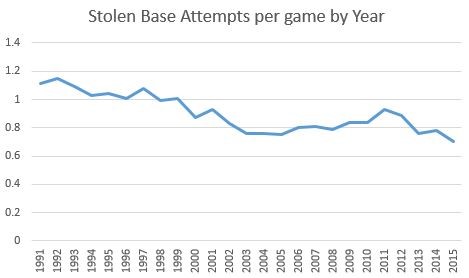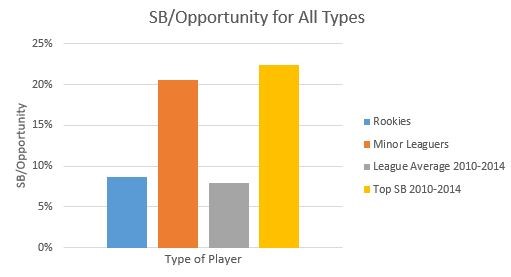Natural Born Stealers: Why Minor League Base Stealers Continue Their Sneaky Ways in the Majors
Speed kills. “Just ask Billy Hamilton. As a rookie in 2013, Hamilton used his 4.4 speed (which had previously earned him scholarship offers to play wide receiver at highly regarded academic institutions such as Mississippi State) to reach base nine times in 22 plate appearances. This somehow translated to 13 stolen bases, which is honestly absurd. However, despite performances like this, I still feel like speed is generally undervalued in baseball compared to other sports.
The reason speed is generally valued more in sports such as basketball and football is because it is almost always on display in those other sports. For basketball, whether it’s a player running to get back on defense, or going coast to coast for a dunk, guys like Russell Westbrook constantly remind us how important speed can be. For football, athletes are either trying to block or tackle large, terrifying, athletes, or trying to avoid being blocked or tackled by large, terrifying athletes. In either case, speed sure as hell helps the cause.
For baseball, however, speed is really not that vital for all positions. If you are ever looking for an example for why Wikipedia is not a reliable source, look no further than Bartolo Colón’s page. I absolutely refuse to believe he weighs 265 pounds, but either way, the guy can barely walk, let alone be known for his speed. This notion is not just for pitchers, as despite how fat and slow
Prince Fielder may be, I don’t recall hearing anyone complain about how fast Fielder circles the bases following another home run. With that said, there is a time when speed could not be more important in baseball: stealing bases.
To say stolen bases have become less prevalent in MLB would be an understatement.

There have been over 0.4 fewer stolen base attempts per game in the 25-year period from 1991 to 2015. Stolen bases have become so rare that they’re at their lowest since the mid-60s.
This is also exactly why you, a DFS baseball player, should care more now than ever about stolen bases. If there’s one thing we’ve learned from Fantasy Baseball for Smart People, it’s that stolen bases and home runs are game-changers daily fantasy.
So if I were to tell you that there was a crop of undervalued players who attempt to steal bases at over twice the rate as the MLB average, and more successfully as well, might that be some information you would be interested in?
The Study
This group of players I speak of is of course rookies…but not just any rookie prospects. The rookies I am looking at in this study are those who achieved an AAA season of at least 20 stolen bases. The reason why I chose 20 stolen bases as a cut-off is because this gave me roughly the top 40 base-stealers each year from 2007 to 2014 in terms of bulk stolen base production.
With this crop of 330 minor leaguers who had a Minor League season with at least 20 successful stolen base attempts, how did they do in the Majors? Well, 132 of them managed to put together a rookie season in the Majors consisting of at least 50 at-bats, and I want to look at two key factors when determining their stolen base success.
SB Rate
SB Rate (stolen base rate) is very simple. Stolen bases divided by total number of stolen base attempts: how successful has player X been when he attempts to steal a base?

The rookies (blue bar) represent all major league rookies from 2007 to 2014, the Minor Leaguers (orange bar) represent the 132 players described above in their rookie season, the gray bar is simply the league average stolen base rate from 2010 to 2014, and the yellow bar shows how the top MLB base-stealers (those with 20 or more stolen bases in a season) performed.
These top base-stealing Minor Leaguers are doing great! With a SB rate over 75 percent, they are swiping bases with more success than both regular rookies and league-average players. These Minor Leaguers are not quite as good as the top MLB base-stealers, but it’s closer than you’d think. Individually, over 37 percent of the Minor Leaguers posted a SB rate better than the top MLB base-stealers. So out of the 132 players, nearly 50 of them found themselves in the MLB VIP club as one of the most successful base-stealers in their rookie year.
SB/Opportunity
When doing this study, I couldn’t help but wonder: is there a way to quantify how often a player attempts to steal versus simply stolen base attempts? For this particular study, I wanted to try and differentiate this, as a guy who steals five bases when reaching base 20 total times is obviously worth more than a guy who steals five bases when reaching base 200 total times, but SB rate does not reflect this.

Enter SB/Opportunity. This statistic takes a players total stolen base attempts, and divides it by the sum of a player’s total hits and walks, subtracted by their home runs and triples. Essentially, this stat asks the question: how many times does a player steal when he is on first or second base? Because not all rookies are freaks like Jonathan Villar and pull off stunts like this.
The above chart has the same player pools as before, but we see a much larger discrepancy than we did for SB rate by player. What this chart shows is that while rookies and league-average MLB players attempt to steal bases on fewer than nine percent of their opportunities, top MLB and Minor League base-stealers attempt to steal bases on more than 20 percent of their opportunities. The top rookie base-stealers being studied are a notch below the productivity of the top MLB base-stealers, but once again these Minor League speed demons are putting the rest of the rookies and league-average players to shame.
Actionable DFS Info
AGE SHOWS NO CORRELATION WITH ROOKIE STOLEN BASE RATE. Just wanted to get that off my chest in case you thought I forgot to check. There’s no correlation. I checked. Let’s move on.
Top base-stealing Minor Leaguers have had very successful rookie season SB rates. With successful steal attempts on over 75 percent of their opportunities, the players studied have been great at stealing bases in their rookie season. Not quite as great as the top MLB base-stealers are (79 percent success rate!!!), but still pretty good, and definitely better than league-average players and other rookies.
Top base-stealing Minor Leaguers have been attempting to steal bases in over 20 percent of their opportunities, which is over 250 percent more often than the league-average player. Not only are these fast rookies more successful than league average players at stealing bases, they are attempting to do so two and a half times more often. With these rookies attempting to steal bases on over 20 percent of their opportunities versus rates under nine percent for both rookies and league-average players, there’s a big potential to find value on cheap rookies who steal bags at elite rates. Top MLB base-stealers still take the cake with a SB/opportunity at over 22 percent, but based on the numbers above, you best believe that these same Minor Leaguers are working their way right to the top, and quickly.
When you are looking for players who can steal bases, look no further than rookies who have already proven the ability to do just that in the Minors. Overall, AAA Minor League players from 2007 to 2014 who have stolen at least 20 bases once in the Minors have posted SB rates and SB/opportunity rates nearly at the level as top MLB base-stealers, i.e. it doesn’t take base-stealers long to develop their craft in the pros. I’m not saying you should necessarily target these rookies over the proven MLB base-stealers, but they are for sure going to be at a better value, and they have proven to be better options than league-average players.
Plus, do you really want to risk not getting the chance to root for this?